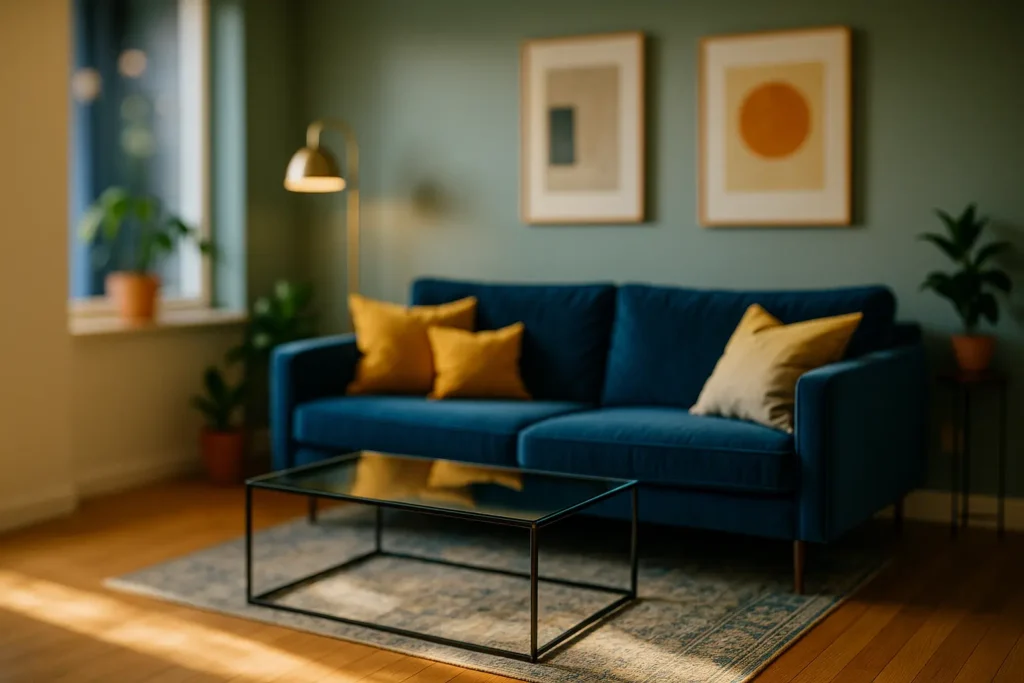In the vibrant world of interior design, nothing speaks louder than colors. They are the voice of our spaces, narrating stories about who we are and the feelings we wish to convey. Every shade, from the tranquil blue of a serene bedroom to the passionate red of a lively living room, serves a purpose. As we paint our homes, we also paint our identities, expressing our love and values through carefully chosen hues. Let’s dive into what your home color palette might be revealing about you.
Understanding Your Emotional Blueprint
Colors are fundamentally linked to our emotions, acting as silent communicators of our inner states. When we choose a particular color scheme, we are subconsciously aligning our environments with our emotional landscapes.
Consider the calming effect of blue. This color is often associated with tranquillity, making it a popular choice for bedrooms and bathrooms where we seek peace. If your home is adorned with shades of blue, it suggests a desire for calmness and introspection.
On the flip side, red is invigorating and bold, symbolizing energy and passion. It’s the ideal choice for spaces meant to stimulate conversation and activity, like a dining room or living room. Embracing red in your home might indicate that you thrive in dynamic and lively environments.
Incorporating green into your home might reveal a nurturing spirit. Green is synonymous with nature, growth, and renewal. It promotes a sense of balance and harmony, suggesting a love for the earth and a peaceful life.
White, often used for its clean and pure appearance, symbolizes simplicity and clarity. If your home is predominantly white, it might reflect a minimalist mindset, valuing order and calm.
Ultimately, every color choice tells a deeper story. The hues we select not only create an aesthetic but also forge a connection between our external spaces and internal selves.
Creating Harmony with a Balanced Palette
In the pursuit of a beautiful home, achieving harmony is the ultimate goal. A well-balanced color palette not only elevates your interior’s aesthetic but also enhances the functionality and mood of each room.
Let’s start by understanding the basics of color palettes. A complementary palette, for instance, uses colors opposite each other on the color wheel, like blue and orange, to create a vibrant and lively space. This approach works well in areas meant for entertainment and socializing.
Analogous palettes, on the other hand, use neighboring colors like green, blue, and turquoise. This scheme creates a soothing and cohesive look, perfect for bedrooms and personal spaces where relaxation is key.
Monochromatic palettes focus on varying shades of a single color, providing depth and elegance without overwhelming the senses. Imagine a living room in shades of grey or a bathroom adorned in subtle blue hues. Monochromatic schemes speak of sophistication and unity.
It’s crucial to consider the room’s function and desired mood when selecting colors. Warm colors like red and yellow can make spaces feel cozy and inviting, while cooler shades like blue and green can create a refreshing and open atmosphere.
By thoughtfully selecting a harmonious palette, we craft an environment that feels just right, encouraging us to linger and enjoy our surroundings. Balance is not just about color but the feeling it evokes, creating a sanctuary tailored to our lives.
Exploring the Power of Accent Colors
While your primary color palette sets the tone for your home, accent colors serve to enliven and punctuate your spaces. These strategic pops of color can transform an ordinary room into an extraordinary expression of personal style.
Accent colors are often bold, injecting personality and flair into a space. Whether through a vibrant piece of art, a striking rug, or a daring wall paint choice, these colors draw attention and break the monotony of a single-hued environment.
Consider using red accents in a neutral room to create a focal point that energizes and draws the eye. Meanwhile, a blue accent wall can add depth, creating a serene backdrop that invites reflection.
For those who prefer a subtler approach, green accessories like plants or cushions can add life and vibrancy without overwhelming the senses. Green accents work beautifully in neutral or earth-toned rooms, complementing the natural hues.
The key to successful accent colors lies in their placement and intensity. They should enhance, not overshadow, the primary color scheme. When done right, these vibrant touches can bring a room to life, reflecting our unique style and creating a dynamic, inviting atmosphere.
Accent colors are a powerful tool, allowing us to experiment and change the mood of our spaces with ease. They are the final brushstroke in our personal canvas, adding character and depth to our homes.
Transforming Spaces with Paint and Personality
The transformation of a home often begins with the simple yet powerful application of paint. It’s an art form in itself, allowing us to instill personality into our spaces with every brushstroke. By choosing the right color, we can redefine a room’s atmosphere and make it truly ours.
Painting is not just about aesthetics; it’s about creating spaces that resonate with our souls. A soft white wall can evoke a sense of purity and space, while a deep blue can envelop us in a cocoon of calm. Each choice of paint communicates something about our preferences and aspirations.
Consider the impact of red paint in a kitchen. This bold choice speaks to a love of energy and life, encouraging social interactions and hearty meals. Conversely, a green accent wall in a living room can create a tranquil oasis, perfect for unwinding after a long day.
It’s essential to remember that paint is forgiving and versatile. Feeling adventurous? Try a daring black feature wall or a vibrant yellow ceiling. These unexpected choices can become conversation starters, reflecting a willingness to step outside the norm.
In the end, every color choice we make, every wall we paint, is an extension of ourselves. It aligns our living spaces with our inner worlds, turning a house into a home that speaks our language and cradles us in comfort and familiarity.
As we journey through the vibrant world of color in our homes, we begin to understand that colors are more than mere decoration. They are the silent narrators of our lives, whispering tales of who we are and what we cherish.
Our color palettes speak volumes about our desires and the environments we seek to create. From the calming embrace of blues to the fiery passion of reds, each hue we choose is a brushstroke in the masterpiece of our lives.
In crafting our home color palettes, we reveal our true selves, painting our comforts, dreams, and aspirations onto the walls of our world. So, let’s embrace the power of color, for it is through these shades that our stories come to life, enriching our homes and our hearts.
FAQ
What does a neutral color palette in a home suggest about the homeowner’s personality?
A neutral color scheme often reflects a desire for calmness and simplicity. Homeowners who prefer this palette tend to value balance, minimalism, and a clutter-free environment. They might enjoy a classic and timeless aesthetic, focusing on versatility and subtle elegance.
How can bold colors in a home interior reveal the character of its residents?
Bold colors can indicate a vibrant and energetic personality. Individuals who choose vivid hues often embrace creativity, confidence, and a willingness to take risks. These colors suggest a dynamic lifestyle and a preference for making strong statements through design choices.
What does a preference for earth tones indicate about someone’s lifestyle?
A home decorated in earth tones often suggests a connection to nature and an appreciation for the environment. Residents who favor these colors might prioritize sustainability, comfort, and warmth. They are likely to value a grounded lifestyle, emphasizing natural beauty and harmony.
How do pastel color schemes reflect the homeowner’s emotional state?
Pastel colors can convey a sense of serenity, gentleness, and approachability. Homeowners who choose these hues might seek a peaceful environment that fosters relaxation and emotional well-being. This palette is often chosen by those who appreciate subtlety and a soothing atmosphere.
What does a monochromatic color scheme in a home say about its inhabitants?
A monochromatic color scheme often reflects a sophisticated and organized mindset. Residents with this preference might appreciate cohesiveness and structure, valuing clarity and precision. This choice suggests a focus on unity and a keen eye for detail, creating an environment that is both elegant and simple.



